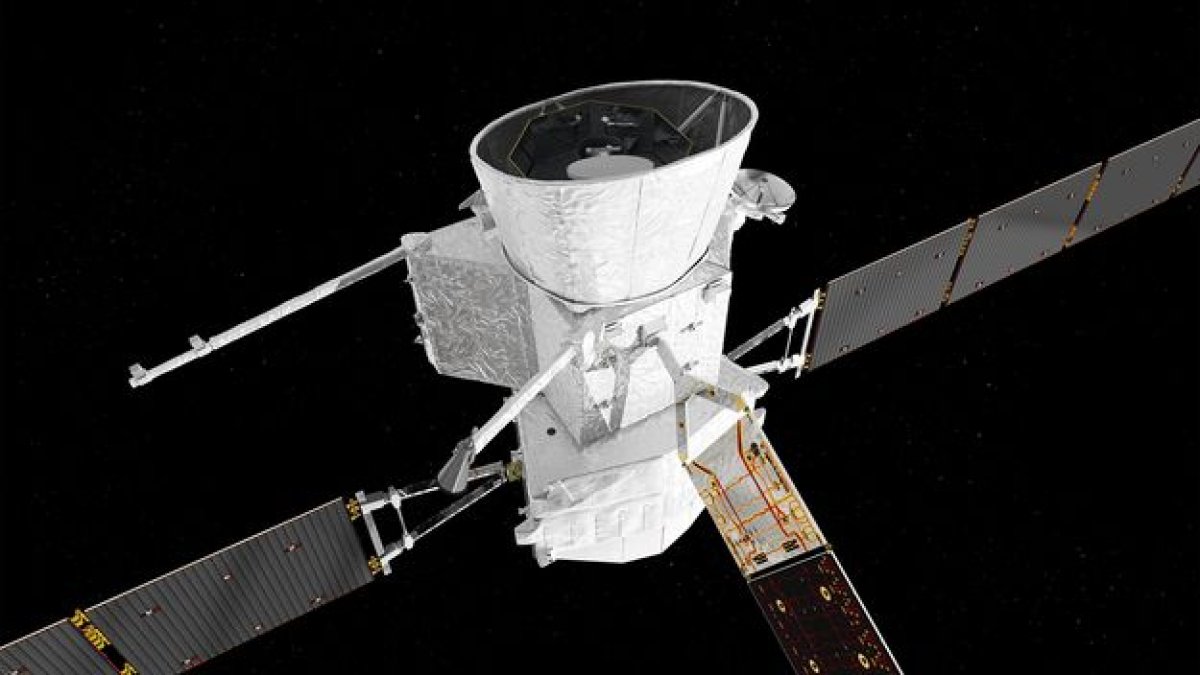Mercury may be the most mysterious planet in the inner solar system. Sitting some 35 million miles from the sun—depending on its orbit—it has virtually no atmosphere. Pummeled by solar wind, surface temperatures swing from -290 F to a scorching 800 F.
Scientific instruments face a treacherous route to probe our solar system's smallest planet. As a result, only two missions have ever gotten close to the hot, dense orb. In October, European and Japanese space agencies ESA and JAXA are set to launch the next mission to Mercury—BepiColombo.
On Wednesday, London's Science Museum unveiled Bepi's full-size structural thermal model to the public. Standing about 20 ft tall, the model has been frozen, toasted and vibrated to make sure the real thing is up to scratch for the long journey ahead.

If all goes well, Bepi will cruise through space for about seven years before it reaches orbit around Mercury. Propelled by electric propulsion and the gravity of Earth, Venus and Mercury itself, the spacecraft will finally reach its destination in late 2025. In the last stages of its journey, Bepi will harness the gravity of Mercury and the sun, travel past the planet and swing back into orbit, like a slingshot.
Then, Bepi will split into two separate orbiters—Europe's Mercury Planetary Orbiter (MPO) and Japan's Mercury Magnetospheric Orbiter (MMO). A host of scientific instruments will probe the planet's surface, interior, magnetosphere and exosphere to shed light on this mysterious body.
Take Mercury's surface. Deep, dark craters whose floors never see sunlight pepper Mercury's poles. On a planet that gets to 800 F, somehow the craters' beds are hiding ice.
Scientists think a dark, organic material might be stopping this ice from melting, Suzanne Imbers, an associate professor in Space Physics at the U.K.'s University of Leicester, told Newsweek. "What is this stuff—this mysterious dark material in the permanently shadowed craters of Mercury? How did it form? Is that what's protecting the ice from disappearing?" Bepi, she hopes, will answer some of these questions.
Imbers' own area of research is Mercury's magnetosphere. Her team is behind Bepi's Mercury Imaging X-Ray Spectrometer, or MIXS, which will measure X-rays given off by the planet's surface. This information can help scientists understand the planet's formation and composition.
Understanding Mercury's weird magnetic activity can teach scientists about Earth. Although Mercury's magnetic field is weak, it interacts with solar wind plasma in incredibly dynamic ways. Similar but less intense interactions affect our own planet. Auroras, electricity grids, and even satellites in orbit are at the mercy of solar winds. "If we can work out what is happening at Mercury, we can apply that knowledge to the Earth and try and work out ways to protect our society from the worst impact of the sun," Imbers explained.
Beyond the science itself, the ESA's Joe Zender, BepiColombo deputy project scientist, tells a story of human achievement. The project brought together space agencies, companies, engineers and scientists from around the world. "We have many [European] countries involved. We have colleagues in Japan, we have one instrument from Russia, [and] we have colleagues in the U.S.," Zender told Newsweek.
The challenge now, he added, is to harmonize this massive project. Bepi presents as many technical obstacles as it does scientific solutions. The spacecraft has a lot of stakeholders to please, but faces limits to its power and data capabilities. "We have to find out for each science goal—and we have many of them—which instrument to operate, when do we operate, do we have the power, can we get the data down and so on."
Rather than difficult, Zender says, these decisions should be fun.
Bepi has been the focus of the entire careers of many of its engineers. But Jessica Marshall, a systems engineer from Airbus—the ESA's prime contractor—marveled at the journey still to come. "It's amazing when you think about the time involved in these projects, and where we will be and what we'll be doing." Her 14-month old child, she told Newsweek, will be eight by the time Bepi reaches Mercury.
She's confident the wait for answers will be worth it. Although the journey will be a challenge, engineers are almost certain it will be a success. Back home, they'll communicate with Bepi constantly after its launch, patching its software systems as required.
Shawn Orford, who worked on the sophisticated system that will lock the MPO and MMO orbiters together before separating them seven years down the line, shares Marshall's confidence. But seven years, he added, "is a long time to wait."
Uncommon Knowledge
Newsweek is committed to challenging conventional wisdom and finding connections in the search for common ground.
Newsweek is committed to challenging conventional wisdom and finding connections in the search for common ground.
About the writer
Katherine Hignett is a reporter based in London. She currently covers current affairs, health and science. Prior to joining Newsweek ... Read more
To read how Newsweek uses AI as a newsroom tool, Click here.








